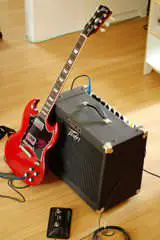Während Akustikgitarren keine zusätzliche Ausrüstung benötigen, benötigen E-Gitarren Strom und Verstärker, um Musik zu produzieren. Der Musikstil, der auf elektrischen und akustischen Gitarren gespielt wird, ist sehr unterschiedlich – akustische Gitarren werden mit „sanfter“ Musik wie Folk und Country assoziiert , während elektrische Gitarren für Metal- und Rockmusik verwendet werden. Im Vergleich zu einer E-Gitarre ist eine Akustikgitarre billiger, für Anfänger jedoch möglicherweise etwas schwieriger zu erlernen.
Contents
Vergleichstabelle
| Acoustic Guitar | Electric Guitar | |
|---|---|---|
 |
 |
|
| Classification | String instrument (plucked, either by fingerpicking, or with a pick.) | String instrument (plucked, either by fingerpicking, or with a pick.) |
| Produces sound using | Sound board | Pickups |
| Sound relies on | Vibrations through soundboard | Magnetic interactions |
| String type | Metal, gauge depends on tuning | Metal, gauge depends on tuning |
| Size | Larger | Smaller |
| Requires power | No | Yes |
| Ease of play | Harder (thicker neck , bigger body) | Easier (thinner neck, smaller body) |
| Cost | $150 for decent instrument | $250 and up |
How Guitars Work

When the strings of an acoustic guitar vibrate, they also vibrate the soundboard, which is a wooden piece on the front of the guitar that magnifies the sound. The tension of the strings can be changed with tuning heads, and by pressing your fingers between the frets – when plucked, these strings produce different sounds.
Electric guitars also use tuning pegs and frets to change the tension of strings and so change the sound. However, while an acoustic guitar’s strings send vibrations to a soundboard, which produces the sound, the metal strings of an electric guitar interact with the magnetic pickups (a set of six magnets wrapped in copper wire) on the guitar, causing them to produce a current. This current is passed through a preamplifier, which reduces noise and interference and adds power, and the current is then sent through digital processors to amplify it, before passing through the speakers.
<iframe width=”640″ height=”360″ frameborder=”0″ allowfullscreen src=”https://www.youtube.com/embed/4GkAOzpOFMk?iv_load_policy=3&rel=0″></iframe>
Strings, Knobs and Body
An acoustic guitar is hollow, with a round hole in its face, and six strings made of steel. The acoustic guitar has heavier gauge strings, which have larger vibrations and so create more sound. These are harder to press down and bend.
An electric guitar has thinner strings. Because of this, it also has a thinner neck and a smaller body.
Learning Curve
The electric guitar is easier to play, because it is easier to setup the guitar, the strings are closer to the frets, and the player does not need to press the strings as hard. However, although they are easier for beginners to play, some of the different knobs and features can take time to learn.
Cost
A decent acoustic guitar will cost around $150, while an electric guitar will cost double that, including the cables, amplifier, etc. The best-selling guitars on Amazon range in cost from $40 to $200.
Of course, like any other musical instrument guitars can cost tens of thousands of dollars. But a more expensive guitar does not necessarily produce significantly better quality sound, as can be seen (or heard) in this YouTube video that compares 3 guitars with a price of $100, $700 and $10,000.
Maintenance
Both types of guitar should be kept away from extreme heat , cold or moisture and protected from cleaning solutions or sharp objects that could scratch or dent it. Keeping the instrument in a case can help with this. Old guitar strings need to be replaced when the sound becomes dull, and at this time, the frets and fretboard should also be cleaned. Both types of guitar also need frequent tuning. Acoustic guitars benefit from guitar humidifiers, which go between the strings and prevent the wood from drying out. However, electric guitar maintenance also includes adjusting the pickups with a screwdriver, and taking care of the amp.
Other Pros and Cons
Acoustic guitars do not require any additional equipment, such as amplifiers or power .
An electric guitar may lose some sound quality, due to the electric transfers it involves. However, others argue that it has better sound because it can enhance, amplify and modify the sound.
Choosing: Is electric or acoustic right for you?
The choice of guitar essentially comes down to what style of music you want to play. Acoustic guitars are most frequently associated with folk, country, jazz, and bluegrass music; they’re likely to accompany (or be accompanied by) vocals, the fiddle , and/or piano. Electric guitars are used for metal and rock music, as well as some electronica, and is more likely to be heard alongside loud drumbeats and electric bass guitar.
<iframe width=”450″ height=”338″ frameborder=”0″ allowfullscreen src=”https://www.youtube.com/embed/nVYEI-NdogA?iv_load_policy=3&rel=0″></iframe>
References
- Maintaining a guitar
- Basic guitar care and maintenance
- How acoustic guitars work
- How does a guitar work? – University of New South Wales
- How an electric guitar actually works